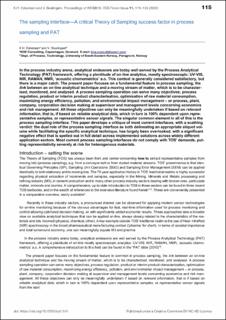| dc.description.abstract | In the process industry arena, analytical endeavors are today well served by the Process Analytical Technology (PAT) framework, offering a plentitude of on-line analytics, mostly spectroscopic: UV-VIS, NIR, RAMAN, NMR, “acoustic chemometrics” a.o. This context is generally considered satisfactory, but there is a major catch. The present paper focuses on a fundamental feature in process sampling, the link between an on-line analytical technique and a moving stream of matter, which is to be characterised, monitored, and analysed. A process sampling operation can serve many objectives; process regulation, product or interim product characterisation, optimisation of raw material consumption, maximizing energy efficiency, pollution, and environmental impact management ‒ or process, plant, company, corporation decision making at supervisor and management levels concerning economics and risk management. All these objectives can only be meaningfully undertaken if based onrelevant information, that is, if based on reliable analytical data, which in turn is 100% dependent upon representative samples, or representative sensor signals. The singular common element in all of this is the process sampling interface. This paper develops a critique of most current interfaces, with a scathing verdict: the dual role of the process sampling interface as both delineating an appropriate aliquot volume while facilitating the specific analytical technique, has largely been overlooked, with a significant negative effect that is spelled out in full detail across implemented solutions across widely different application sectors. Most current process sampling interfaces do not comply with TOS’ demands, putting representativity severely at risk for heterogenous materials. | en_US |

